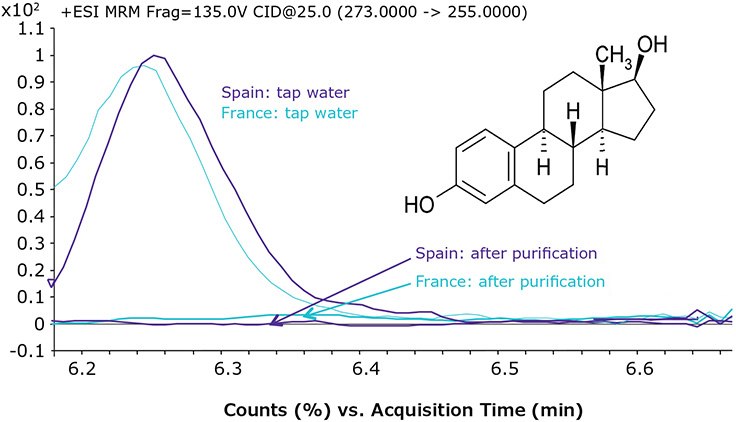Trace LC-MS/MS Analysis of Hormones in Tap Water
Anastasia Domanov1, Matias Kopperi2, Jevgeni Parshintsev2, Patrik Appelblad3, Stephane Mabic1
1Lab Water Solutions, Merck, Guyancourt, France, 2University of Helsinki, Department of Chemistry, Laboratory of Analytical Chemistry, Finland, 3Advanced Analytical, Merck, Solna, Sweden
Three hormones were detected by LC-MS/MS in the tap water of different laboratories. After purification by Milli-Q® water purification systems, the hormones were no longer detected in the product ultrapure water, which could then be used for LC-MS/MS analyses of hormones.
Role of ultrapure water in LC-MS/MS analyses
HPLC coupled with mass spectrometry (MS) is used for the trace analysis of organic compounds to address environmental, health and safety concerns. These methods have very low detection limits, making it critical to avoid, or at least minimize, contamination during the experimental process. Components of the HPLC instrument, the mass spectrometer,1 sample handling and manipulation2 as well as the reagents and solvents used in the analyses, can all contribute to contamination issues.
Water plays an important role in HPLC, where it is used extensively in the workflow. It is essential that the analytes detected come from the samples, and not from the water used in various steps of the experiment (such as in the preparation of samples, standards, blanks, and eluents; or rinsing/flushing of the HPLC and MS systems).
Trace analyses of hormones
Hormones are examples of contaminants of emerging concern (CEC) that have been detected in environmental and drinking waters around the world in trace amounts.2,3 Even at very low concentrations, CECs could potentially exert ecotoxicological effects.3
Three tap water samples from France, Spain and China were analyzed. Estradiol and androsterone were detected in tap water in laboratories in France and Spain, while corticosterone was detected in the water sample from the Chinese laboratory. Table 1 summarizes the results of the LC-MS/MS analysis and Figure 1 shows the multiple reaction monitoring (MRM) chromatogram of estradiol.
The ultrapure water produced in each laboratory was analyzed for the presence of these three hormones using the same method as for tap water analysis. In all three laboratories, no hormones were detected in the product ultrapure water (Table 1).

Figure 1. MRM chromatogram (ESI+) of estradiol in tap water and in ultrapure water after purification using Milli-Q® systems. Data reported are one-time, one-location data and are not representative of water in the various countries where samples were taken.
The extent of organic contamination is important in trace LC-MS/MS analyses. The level of total oxidizable carbon (TOC) provides a general indication of organic contamination. A TOC level below 5 ppb is recommended for LC-MS/MS, which is achieved by Milli-Q® ultrapure water systems.
Experimental conditions for the analysis of hormones in water
Lab Water Purification Systems
In the Chinese and the Spanish labs, a Milli-Q® water pretreatment system incorporating intelligent reverse osmosis, Elix® eletrodeionization and a bactericidal UV lamp, similar to the Milli-Q® IX system, was used. Following the pretreatment step, a Milli-Q® polishing system, similar to the Milli-Q® IQ 7000 system, was used to deliver ultrapure water.
In the French lab, an integrated pure and ultrapure Milli-Q® water purification system, similar to the Milli-Q® IQ 7003 system, was used to deliver ultrapure water.
Instrumentation
LC-MS analyses were performed on an Agilent®1290 Infinity HPLC system coupled to an Agilent® 6420 Triple Quadrupole system (ESI+, MRM). A Purospher® STAR RP-18 endcapped (2 µm) Hibar® HR 50-2.1 column was used to separate the hormones under gradient elution conditions.
Samples and Standards
Quantitation was performed using the standard addition method (standards: androstenedione, androsterone, corticosterone, cortisone, estradiol, estrone, progesterone, OH-progesterone, testosterone). 1-liter samples of tap water and ultrapure water from Milli-Q® water purification systems were collected and enriched by Solid Phase Extraction (SPE) before LC-MS/MS analysis. The samples were analyzed in triplicate and the quantitation was performed following the standard addition method.
Benefits of ultrapure water to test hormones in environmental samples
LC-MS/MS analyses rely on high quality solvents that are free of contaminants that could cause interferences. Even if a scientist's molecules of interest are present in the tap water of their lab, Milli-Q® systems can deliver ultrapure water free of organic contaminants, making it suitable for the most sensitive LC-MS/MS analyses.
Related Products
References
To continue reading please sign in or create an account.
Don't Have An Account?